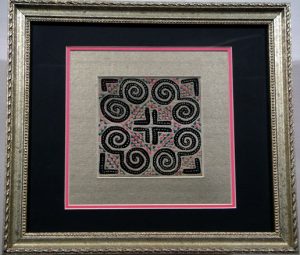Description
DESCRIPTION: A Nagoya Obi is more of a structural nomenclature than a definition of a type of Obi from Japan’s past. Originally, there were Maru Obi, Fukuro Obi and Han Haba Obi. The most formal and expensive was the Maru Obi, wherein there was but one seam down the length of one side; the Fukuro Obi which had two seams with differing fabric on the back from the front; while the Han Haba was traditionally a man’s narrow obi. The Nagoya Obi resulted from the desire on the part of women during the 1800s to have an obi that was easier to tie than the traditional Maru or Fukuro Obi. Prior to the twentieth century, clever women began to double over the wider portion of the obi to create a new structure that was one-third traditional width and two-thirds half the width. This became the Nagoya Obi which began to be produced commercially just prior to the 1920s.
This fascinating Obi represents one of the earlier Nagoya Obi, having been created from a Fukuro Obi, which incorporated one full length of heavy, handwoven, black satin silk and one length that displays the extraordinary embroidery. The handmade gold threads appear among the swirls of curls adding lustrous imagery. On this Obi, the gold threads are “couched” within the riotous coat of the Shi Shi and on the bottom of the obi to add impact and status. The handmade, pure gold threads were created by painting liquid gold on rice paper, and then wrapping this around Silk threads. Because this thread was so fragile, it could only be laid on top of the fabric and “Couched” to it.
The Shi Shi or Lion Dog motif took a long route to Japan, traveling from both China and Korea. In China, the “Kara-shishi” was created in the image of what the Chinese imagined a Lion to look like…hearing of this great beast from the Buddhists in India, but never actually having seen one. Thus, its marvelous and mythical appearance actually resembled the Pekinese pug or “lion dog” kept at the Imperial Court. From China, this mythical beast went to Korea, where it metamorphosed from the lion (cat) to a dog and became a “Koma-inu” or Korean Dog. By the time this image arrived in Japan, it combined both the Korean Dog and the Chinese Lion. Its’ final shape, portrayed so well on this Obi, incorporates the heavy Buddhist influence prevalent in Japan: a fierce distinctive square head, broad nose, and large eyes dominated by the tightly curled ringlets on its forehead. The body displays abundant and wild floral groupings while its legs appear bushy. In the Buddhist faith, the Shi Shi is considered a guardian of the temple. If its mouth is open, it is a male (Yang), while the female (Yin) often has a cub beneath her feet. In Japan, the male and female often appear together, as the Shinto Religion also has adopted them as the outer guardians of their Shrines.
All the artistic skills applied to the creation of this Obi, required tremendous talent, and laborious and time-consuming skill.








